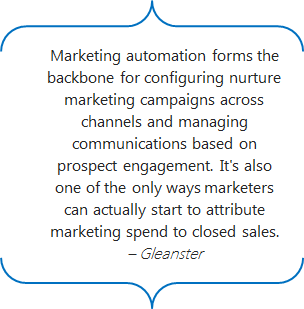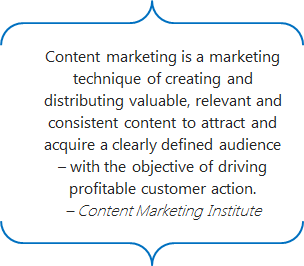This is a January 2015 update to the original April 2014 post. It’s been expanded from 70 stats to 87. We have not changed the URL to keep the integrity of inbound links.
Many of the marketing automation stats we regularly use – to make strategic decisions, craft presentations, prepare for sales calls – are getting a bit long in the tooth.
Case in point: “Companies that excel at lead nurturing generate 50% more sales-ready leads at 33% less cost.”
It’s a great stat that gets a lot of traction; I just found it on 3 different blog posts published within the last week.
It’s also 3 years old. (You can find it in the Q2 2011 Forrester Wave™ report.)
Here’s another popular one: “Companies that blog have 55% more website visitors, 97% more inbound links, and 434% more indexed pages.”
It’s from 2009.
Am I saying that a little age makes data irrelevant?
Not at all.
However, when it comes to digital marketing, more than 2 years (some would argue less) is perceived as being out-dated – the difference between “latest” and “legacy” – even if the stat still holds water.
So we set off to uncover the most recent marketing stats
Our goal was two-fold:
- Curate stats that were originally published no earlier than mid-2012
- Share only those with specific relevance to the business benefits of marketing automation
The results are below, with full source notation and links.
Note that many of the stats are germane to more than one category, which is testament to the new marketing landscape of blurred lines and interconnectedness. We’ve done our best to put them in their most natural spot.
Jump to the category of interest, or scroll to your heart’s content.
- Marketing Automation
- Content Marketing
- Email Marketing
- Segmentation, Targeting & Personalization
- Lead & Relationship Management
- Sales & Marketing Alignment
- Search Engine Optimization
- Blogging & Social Media Marketing
- Data & Analytics
The Stats
MARKETING AUTOMATION
- 79% of top-performing companies have been using marketing automation for more than 2 years. (Gleanster, Q3 2013 Marketing Automation Benchmark, Aug 2013)
- B2B marketers who implement marketing automation increase their sales-pipeline contribution by 10%. (Forrester Research, The Forrester Wave™: Lead-To-Revenue Management Platform Vendors, Q1 2014, Jan 2014)
- 58% of top-performing companies (defined as those where marketing contributes more than half of the sales pipeline), have adopted marketing automation. (Forrester Research, Gauging Your Progress and Success, Dec 2013)
- 25% of Fortune 500 B2B companies have adopted marketing automation. (ClickZ, Fortune 500 B2B Adoption of Marketing Tools study, Feb 2013)
- 63% of companies that are outgrowing their competitors use marketing automation. (The Lenskold and Pedowitz Groups, 2013 Lead Generation Marketing Effectiveness Study, Nov 2013)
- CMOs at top-performing companies indicate that their most compelling reason for implementing marketing automation is to increase revenue (79%) and get higher quality leads (76%). (Gleanster, Q3 2013 Gleanster Marketing Automation Benchmark, Aug 2013)
- Companies using marketing automation see 53% higher conversion rates (initial response-to-MQL) than non-users, and an annualized revenue growth rate 3.1% higher than non-users. (Aberdeen Group, Marketing Lead Management Report, Jul 2012)
- 78% of successful marketers cite marketing automation systems as most responsible for improving revenue contribution. (The Lenskold and Pedowitz Groups, 2013 Lead-Generation Marketing Effectiveness Study, Nov 2013)
- B2C marketers who take advantage of automation – which includes everything from cart abandonment programs to birthday emails – have seen conversion rates as high as 50%. (eMarketer, Email Marketing Benchmarks, Feb 2013)
- Companies that use marketing automation are 3 times more likely than companies without automation to track and attribute their content-marketing efforts to multiple touchpoints (36% to 11%). (The Lenskold and Pedowitz Groups, 2013 Lead Generation Marketing Effectiveness Study, Nov 2013)
- Among CMOs, the most important criteria for a marketing automation system are ease-of-use (92%) and the ability to tie marketing performance to sales (72%). (Gleanster, Q3 2013 Gleanster Marketing Automation Benchmark, Aug 2013)
- Among B2B marketing managers, the most important criteria for a marketing automation system are (1) price, (2) product integration (e.g., CRM, social, web, mobile), and (3) ease of use. (Pepper Global, Marketing Automation Trends Report 2014, Sep 2013)
- Company size matters. Marketing automation adoption is tied to the number of employees a company has, as itemized below. (Buyer Zone, The State of B2B Lead Generation 2013 Report, Aug 2013)
- 76% – larger companies (> 100 employees)
- 26% – mid-sized companies (10-100 employees)
- 18% – small companies (< 10 employees)
- Company revenue matters. Marketing automation adoption is tied to annual revenue, as itemized below. (Raab Associates, Marketing Automation 2014 Industry Overview, Feb 2014)
- 60% – large companies (> $500M revenue)
- 10% – mid-sized companies ($20M – $500M revenue)
- 5% – small companies ($5M – $20M revenue
- 3% – micro companies (< $5M revenue)
- Companies that have adopted marketing automation display notable advantages compared to companies that have not adopted a marketing automation system, as highlighted below. (The Lenskold and Pedowitz Groups, 2013 Lead-Generation Marketing Effectiveness Study, Nov 2013)
- 45% of companies with marketing automation regularly repurpose content for efficiency, compared with 28% of companies without marketing automation
- 54% of companies with marketing automation capture intelligence for the sales team, compared to 25% without
- 49% of companies with marketing automation customize content to the Buyer Journey stages, compared to 21% without
- 59% of companies with marketing automation are able to use intelligent targeting to trigger content, compared to 17% without
- Among B2B marketers, the #1 benefit of marketing automation is generating more and better leads. Additionally, 75% of the companies using marketing automation implemented their platform in less than 6 months. (Pepper Global, Marketing Automation Trends Report 2014, Sep 2013)
CONTENT MARKETING
- Per dollar spent, content marketing produces 3 times more leads than paid search. Additionally, it costs less than paid search: 31% less for small and mid-sized companies and 41% less for large companies. (Kapost, Content Marketing ROI, Jun 2012)
- DIFFERING GOALS: For B2B marketers, the top goal of content marketing is “lead generation” (80%), whereas B2C marketers cite “brand awareness” as the top goal (79%). (Content Marketing Institute, 2014 Trends reports for B2B and B2C, Oct 2013)
- Companies that use marketing automation are more likely than companies without automation to re-purpose content for efficiency (45% vs. 28%). (The Lenskold and Pedowitz Groups, 2013 Lead Generation Marketing Effectiveness Study, Nov 2013)
- 33% of B2B marketers cite “targeted delivery of content” (i.e., delivering the right content to the right people at the right time) as their biggest challenge. (Forrester Research, The Forrester Wave™: Lead-To-Revenue Management Platform Vendors, Q1 2014, Jan 2014)
- Among B2B buyers, only 9% consider vendor content as trustworthy. And just 4.8% of B2B buyers are willing to provide detailed information in return for white papers. (The CMO Council, Better Lead Yield in the Content Marketing Field, Jun 2013)
- B2B marketers at small and mid-sized companies rate the following content marketing tools as most effective. (Content Marketing Institute, B2B Content Marketing 2014 Benchmarks, Budgets, & Trends Report, Oct 2013)
- Case studies (69%)
- In-person events (67%)
- Blogs (65%)
- Email (65%)
- eBooks (64%)
- Videos (63%)
- Webinars (63%)
- Website articles (59%)
- Research reports (59%)
- White papers (58%)
- 97% of B2B buyers said they give more credence to content that includes peer reviews and user-generated feedback. (DemandGen, 2014 B2B Content Preferences Survey, Jun 2014)
- Companies using video see an average cost per marketing-generated lead at $93, compared to $115 for companies that aren’t using video. (Aberdeen Group, Analyzing the ROI of Video Marketing, Jan 2014)
- The average number of different audiences B2B marketers target with separate content marketing strategies is 4. The average number of content marketing initiatives B2B marketers work on at any given time is 13. (Content Marketing Institute & MarketingProfs, 2015 B2B Content Marketing Benchmarks, Budgets and Trends – North America, Sep 2014)
- Companies that incorporate Responsive Design into their customer experience management programs (i.e., website, forms, email) see a 4X increase in visitor-to-buyer conversion rates and a 2X increase in company revenue compared to companies that don’t use Responsive Design. (Aberdeen Group, Responsive Design Boosts Customer Engagement Results, Apr 2014)
- When comparing the eventual winning vendor to the rest of the considered vendors, 61% of respondents agreed that the winning vendor delivered a better mix of content appropriate for each stage of the purchasing process. (DemandGen, 2014 B2B Buyer Behavior Survey, Jan 2014)
EMAIL MARKETING
- Email marketing has an ROI of 4,300%. (Direct Marketing Association, DMA 2013 Statistical Fact Book, 2013)
- Email marketing was reported as the #1 most-effective tactic for lead nurturing by top-performing B2B marketers (defined as those who reported exceeding annual revenue goals). (Forrester Research, Gauging Your Progress and Success, Dec 2013)
- Email is ranked as the #1 preferred communication channel by consumers for initial introduction to a product/service, learning about a product/service, and post-purchase follow-up about a product/service. (The Economist Intelligence Unit, Mind the Marketing Gap, Mar 2013)
- Triggered email messages average 70.5% higher open rates and 152% higher click-through rates than “business as usual” marketing messages. (Epsilon Email Institute, Q4 2012 N. American Email Trends and Benchmarks, Feb 2013 and Q2 2013 N. American Email Trends and Benchmarks, Jul 2013)
- Over 75% of email revenue is generated by alternatives to generic one-size-fits-all email campaigns. For example, trigger email campaigns account for 21% of email marketing revenue. (DMA UK, National Client Email Report 2013, Feb 2013)
- Triggered email messages are extremely effective for customer engagement and revenue, as exemplified below. (Experian Marketing Services, 2013 Email Market Study, Dec 2013)
- Second abandon-cart reminders (a follow-up abandon-cart message to an initial email) garner an average 54% lift compared to just sending one abandon-cart message.
- Browse emails (messages based on categories or products a customer has viewed) achieve a 3.4x increase in revenue compared to other promotional mailings.
- Thank-you emails achieve a 13x increase in revenue compared to promotional mailings.
- Marketers rate the following tactics as easiest for email list growth. (Marketing Sherpa, Email Marketing Benchmark Survey 2013, Feb 2013)
- Email to a friend (58%)
- Registration during purchase (50%)
- Social media sharing buttons in email (49%)
- Email remains a significantly more effective way to acquire customers than social media — nearly 40 times that of Facebook and Twitter combined. (McKinsey & Company, Why marketers should keep sending you emails, Jan 2014)
- 72% of US online adults send or receive personal emails via smartphone at least weekly. (Forrester Research, Email Marketing Gets Responsive, May 2014)
- Email dominates all other methods of content sharing: 88% of B2B buyers use email to share content. LinkedIn is 2nd (43%) and Twitter is 3rd (35%). (DemandGen, 2014 B2B Content Preferences Survey, Jun 2014)
SEGMENTATION, TARGETING, & PERSONALIZATION
- 96% of B2B marketers say segmentation is the most valuable method for improving conversion rates. (Econsultancy, Conversion Rate Optimization Report, Oct 2012)
- 74% of marketers say targeted personalization increases customer engagement. (Econsultancy, The Realities of Online Personalisation, Apr 2013)
- 59% of marketers report not customizing their lead-nurturing efforts to target the sales funnel and/or buyer stages. (BtoB magazine, 2013 Lead Generation: Optimum Techniques for Managing Lead-Gen Campaigns, Nov 2013)
- Segmentation, personalization, recommendations, and the inclusion of custom database fields in email copy drive 360% higher conversion than a generic email message with a personalized salutation. These are exactly the types of communications that marketing automation helps make repeatable. (Gleanster, 5 Key Milestones for the First 30 Days with Marketing Automation, Nov 2012)
- Personalized emails generate up to 6 times higher revenue per email than do non-personalized emails. (Experian Marketing Services, 2013 Email Market Study, Dec 2013)
- 87% of top-performing marketers say targeting campaigns to audience segments and individual consumers is the largest value driver, with 78% listing segmentation as the #1 marketing-automation capability they can’t live without. (Gleanster, 5 Marketing Automation Capabilities Top Performers Can’t Live Without, Sep 2012)
- 53% of marketers say continued communication and nurturing of their existing customers results in moderate to significant revenue impact. (DemandGen, Customer Marketing: Improving Customer Satisfaction & Revenue Impact, Oct 2014)
LEAD & RELATIONSHIP MANAGEMENT
- 80% of B2B marketers rate “generating quality leads” as the technique with the highest profit potential. Second was “improving sales conversion” at 71%. (BtoB magazine, 2013 Lead Generation: Optimum Techniques for Managing Lead-Gen Campaigns, Nov 2013)
- On average, 60% of marketing leads are generated through direct/outbound marketing, and 40% through digital/inbound channels. (Aberdeen Group, Content Marketing in the L2R Cycle, Jul 2013)
- Inbound marketing is cheaper than outbound, saving an average of 13% in overall cost per lead and over $14 for every new customer acquired versus the costs from outbound strategies. (HubSpot, 2013 State of Inbound Marketing Report, Feb 2013)
- Prospects receive an average of 10 marketing touches from the time they enter the top of the funnel until they’re a closed-won customer. (Aberdeen Group, Marketing Lead Management Report, Jul 2013)
- 74% of top-performing companies use automated lead nurturing. Among average- or less-performing companies that use marketing automation, 2/3 fail to leverage the platform’s lead nurturing capabilities. (Gleanster, Nurture Marketing for the Overwhelmed Marketer, Mar 2013)
- 68% of successful marketers cite lead scoring based on content and engagement as most responsible for improving revenue contribution. (The Lenskold and Pedowitz Groups, 2013 Lead Generation Marketing Effectiveness Study, Nov 2013)
- B2B marketers who have successfully deployed lead nurturing programs average a 20% increase in sales opportunities from nurtured leads versus non-nurtured leads. (DemandGen, Calculating the Real ROI from Lead Nurturing, Aug 2013)
- Sales and marketing professionals agree that lead quality is far more important to revenue than lead quantity. (Aberdeen Group, Sales Enablement: Fulfilling the Last Frontier of Marketing-Sales Alignment, Sep 2013)
- Industry estimates show that data decays at a rate of 25% to 30% per year. (DemandGen, 12 Steps to Ensure You are Marketing to the Right B2B Prospect Lead Database, May 2013)
- Over 50% of leads in the average B2B contact database are obsolete. (IDC, Best Practices Study in B2B Sales Methodologies, Aug 2012)
- B2B marketers say product demos are the most effective method for lead marketing, followed by educational webinars. (BtoB magazine, 2013 Lead Generation: Optimum Techniques for Managing Lead-Gen Campaigns, Nov 2013)
- According to Bain & Company, a 5% increase in customer retention can generate a 75% increase in profitability. And it’s 6 times more costly to acquire a new customer than to keep an existing one. (Forrester Research, Competitive Strategy in the Age of the Customer, Oct 2013)
SALES & MARKETING ALIGNMENT
- 69% of top performing companies cite “cooperation between marketing and sales” as the most critical value driver for maximizing marketing automation ROI. (Gleanster, 5 Key Milestones for the First 30 Days with Marketing Automation, Nov 2012)
- Only 23% of sales professionals say marketers consistently deliver sales-ready leads. (BtoB magazine, 2013 Lead Generation: Optimum Techniques for Managing Lead-Gen Campaigns, Nov 2013)
- 35% of companies with marketing automation regularly capture intelligence for the sales team (from their content marketing efforts), compared with 19% of companies without marketing automation systems. (The Lenskold and Pedowitz Groups, 2013 Lead Generation Marketing Effectiveness Study, Nov 2013)
- Companies that have implemented a marketing automation platform report higher levels of collaboration between sales and marketing, across a number of different dimensions, as itemized below. (Forrester Research, The Forrester Wave™: Lead-To-Revenue Management Platform Vendors, Q1 2014, Jan 2014)
- A 13% collaboration advantage in defining and executing field programs
- A 17% collaborative advantage in capturing insight from customers and prospects
- A 12% collaborative advantage in managing leads and lead pipelines
- 67% of B2B marketers say lead nurturing increases sales opportunities throughout the funnel by at least 10%, with 15% seeing opportunities increase by 30% or more. (DemandGen, 2014 Lead Nurturing Benchmark Study, Oct 2014)
SEARCH ENGINE OPTIMIZATION (SEO)
- Organic search drives the most traffic of all channels, and is responsible for nearly half (47%) of all visits, compared to paid search, which drives only 6% of all visits. (Conductor, 310 Million Visits: Nearly Half of All Web Site Traffic Comes From Natural Search, Jun 2013)
- Nearly 4 out of 5 B2B buyers start their product research online at a search engine. Of those, 71.6% use Google. (Salesforce, The State of Demand Generation, Nov 2013)
- When it comes to Customer Lifetime Value, the highest-value customers arrive through organic search (54% higher than average-value customers). (Custora, E-Commerce Customer Acquisition Snapshot, Jun 2013)
- Leads gained through organic search have a 14.6% rate of close, while leads gained through outbound marketing efforts have a closing rate of only 1.7%. (Top Rank Marketing, War of Words, Jan 2013)
- Best-in-class companies are more than twice as likely as other companies to have a process to review website content for SEO (68% vs 28%). (Aberdeen Group, Benchmark: Web Experience Management from Content to Customer, Jun 2012)
- For ecommerce, organic search is #1 for acquiring new customers, accounting for nearly 16% of first-time-customer purchases. Social channels lag far behind, with Facebook and Twitter accounting for less than 0.25% of new customer acquisitions. (Custora,


